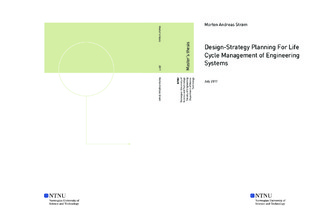| dc.description.abstract | The objective of this thesis is to contribute in developing frameworks and quantitative methods to support uncertainty management of engineering systems, with focus on offshore vessels.
This thesis starts out with a literature review, drawing insight from engineering, management, product development, finance, operations research, and artificial intelligence. The review highlights that uncertainty is as much related to opportunities as it is to vulnerabilities, and that an active management approach is necessary to mitigate the vulnerabilities and to exploit the opportunities. While the engineering domain recognises designing for changeability (i.e. flexibility, adaptability, robustness and agility) as means for handling uncertainty, the managerial domain recognises strategic flexibility.
We propose the Value-Aptitude-Design-Strategy (VADS) framework as a quasi-mathematical expression of the relationship between a stakeholder s aptitude, a design s configuration and the stakeholder s life cycle strategies, linking them to the system s ability to deliver value (i.e. stay successful). From this, we propose the term strategic system, comprising a specific design-strategy configuration, defined as a set of distinct devices used to handle uncertainty. We emphasise the importance of having the strategic system aligned with stakeholders aptitude. This extends the traditional system boundary in engineering, from solely focusing on the relationship between design and its surroundings, to include the managerial dimension. Thus, while the literature is primarily focusing on architecting value robust physical systems, this thesis emphasises the need for identifying value robust strategic systems.
We propose Design-Strategy Planning (DSP) as an active, structured, life cycle approach for managing uncertainty. Building on the VADS framework, DSP focuses on developing, implementing and monitoring strategic systems with the means of handling uncertainty that is aligned with stakeholders aptitude. DSP highlights the importance of dealing proactively with uncertainty by utilising real (in and on) options. The real in options are related to designing for changeability, and the real on options are related to managerial strategies. While some of these options are implemented in the design phase, others are prepared for in the response to various trigger information. The type of response is pre-defined in a contingency plan. To do so, DSP incorporates a monitoring system to locate trigger situations over the system's life cycle.
A Markov decision process (MDP) methodology is presented to support the design-strategy planning framework. The methodology is based on the work of Niese and Singer (2014). Together, DSP and MDP form a holistic decision analysis framework to support uncertainty management. A key benefit is that this framework can capture the dynamic interaction between the changeable system and managerial strategies. As seen in the illustrative case, this insight can be used to select product platforms, to identify the most promising real in options to incorporate in the design phase, and to develop a contingency plan.
The knowledge from this thesis can be important in life cycle management of high-value, complex, engineering systems, with long lifetime, facing high degree of exogenous uncertainty. Hopefully the proposed Value-Aptitude-Design-Strategy framework, Design-Strategy Planning and the Markov decision process methodology will give valuable insight that enables maritime decision makers to better handle uncertainty. | |

